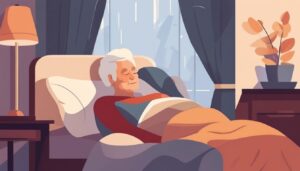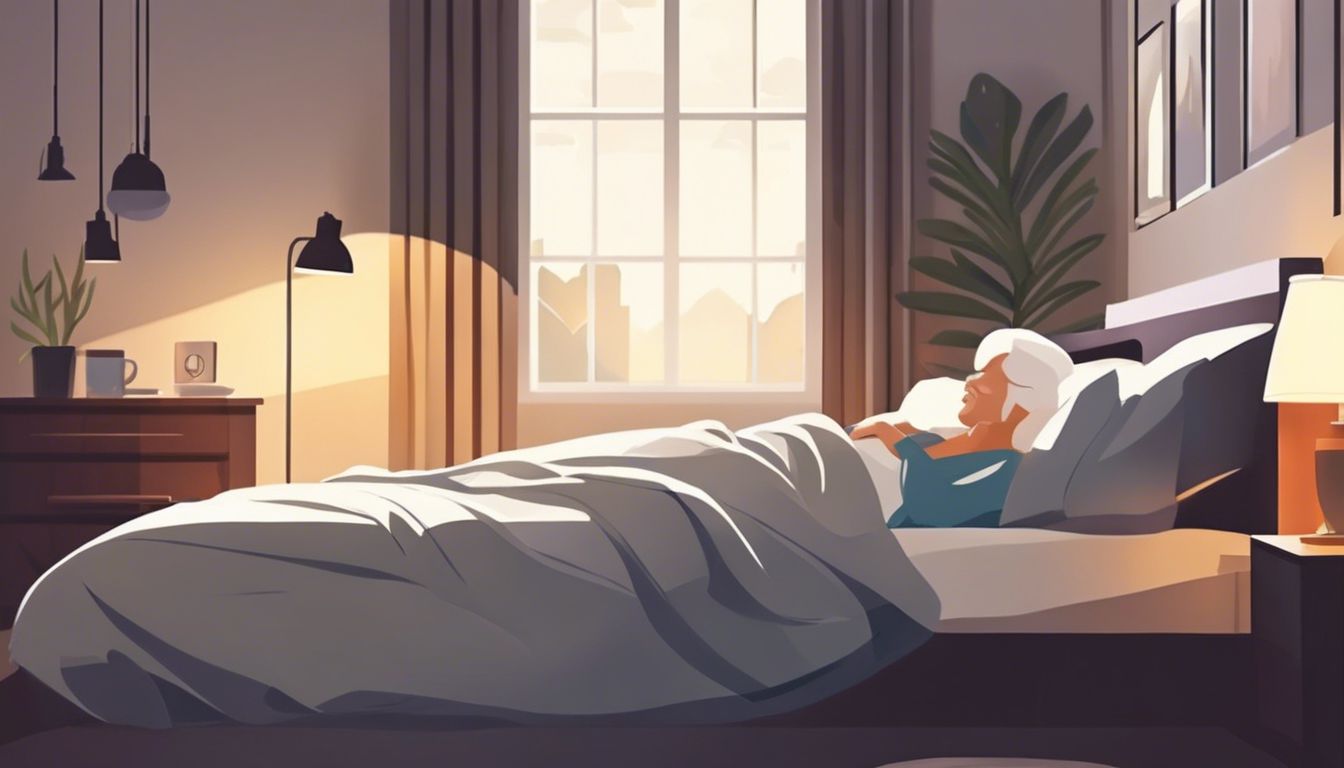Falls in seniors often stem from physical changes, health conditions, and environmental hazards. Learn more about these risk factors and how to address them.
Muscle weakness and balance issues
Muscle weakness stems from inactivity, arthritis, or polymyalgia rheumatica. Poor balance results from weak muscles, stroke, Parkinson’s disease, or medication side effects. These issues increase fall risk in seniors.
Regular exercise strengthens muscles and improves balance, crucial for fall prevention.
Strong muscles and good balance are the foundation of fall prevention in older adults.
Physical therapy and occupational therapy can address specific weaknesses and balance problems. Tai chi and yoga enhance strength, flexibility, and coordination. Home safety modifications like grab bars and non-slip mats further reduce fall risks for seniors with muscle or balance issues.
Vision and hearing impairments
Aging often brings changes to vision and hearing, increasing fall risks. Poor eyesight makes it harder to spot hazards, while hearing loss affects balance. Annual eye exams and biennial hearing tests are crucial for seniors.
Correcting vision problems through cataract surgery or updated glasses can significantly reduce fall incidents. Addressing these sensory issues is vital for maintaining safety and independence in older adults.
Medications that affect stability
Certain medications significantly increase fall risk in seniors. Psychotropic drugs, including antidepressants, antipsychotics, and sedatives, can impair balance and coordination. Blood pressure medications may cause dizziness or fainting, especially when standing up quickly.
Antihistamines often lead to drowsiness and reduced alertness. Taking four or more medicines elevates fall danger, as does changing prescriptions within two weeks. Sleep aids and diabetes treatments can also disrupt stability.
Heart medications may slow heart rate, potentially causing lightheadedness. Regular medication reviews with a healthcare provider help identify and mitigate these risks. The next section explores effective prevention strategies to reduce falls in older adults.
Effective Prevention Strategies for Seniors

Seniors can take steps to prevent falls. Regular exercise and home safety checks are key strategies.
Regular physical activity and balance exercises
Regular physical activity and balance exercises are crucial for fall prevention in seniors. Engaging in these activities improves strength, flexibility, and coordination, reducing the risk of falls by up to 35%.
- Tai Chi: This gentle, low-impact exercise enhances balance and body awareness. Practice Tai Chi for 30 minutes, 3 times a week to improve stability and reduce fall risk.
- Walking: A brisk 20-minute walk 5 days a week strengthens leg muscles and improves cardiovascular health. Use proper footwear with nonskid soles for safety.
- Strength training: Perform resistance exercises twice weekly to build muscle mass and bone density. Focus on leg and core muscles to enhance overall stability.
- Balance exercises: Stand on one foot for 30 seconds, then switch. Repeat 3 times daily to improve equilibrium and reduce the risk of falls.
- Yoga: Attend a senior-friendly yoga class once a week to increase flexibility and body awareness. This practice helps maintain good posture and prevents falls.
- Aquatic exercises: Participate in water aerobics twice weekly to improve strength and balance without straining joints. The buoyancy of water reduces fall risk during exercise.
- Gait training: Work with an occupational therapist to improve walking patterns and reduce the risk of tripping. Practice proper gait techniques for 15 minutes daily.
Home safety assessments and modifications
Home safety assessments identify potential fall hazards in a senior’s living environment. Implementing necessary modifications can significantly reduce fall risks for older adults.
- Remove tripping hazards: Clear walkways of clutter, secure loose electrical cords, and remove or tape down throw rugs.
- Improve lighting: Install bright bulbs, add night lights in hallways and bathrooms, and ensure easy access to light switches.
- Install grab bars: Place sturdy grab bars near toilets, in showers, and along stairways for added support.
- Secure stairs: Repair damaged steps, install handrails on both sides, and mark edges with contrasting tape for better visibility.
- Enhance bathroom safety: Use non-slip mats in showers and tubs, consider a shower chair, and install a raised toilet seat if needed.
- Rearrange furniture: Create clear paths between rooms and ensure frequently used items are within easy reach.
- Address slippery surfaces: Apply non-skid strips to slick floors, especially in kitchens and bathrooms.
- Improve outdoor areas: Repair uneven walkways, install proper lighting, and ensure handrails are secure on outdoor steps.
Regular exercise programs tailored for seniors can complement these home modifications to further reduce fall risks.
Regular health check-ups and medication reviews
Beyond modifying the home environment, regular health assessments play a crucial role in fall prevention. Caregivers should ensure seniors attend scheduled check-ups and medication reviews to address potential health risks.
- Schedule annual eye exams and biennial hearing tests
- Detect vision and hearing impairments early
- Update prescriptions for glasses or hearing aids as needed
- Arrange regular doctor visits to address:
- Foot pain or discomfort
- Dizziness or balance issues
- Chronic conditions like diabetes or heart problems
- Review medications with healthcare providers
- Identify drugs that may affect balance or cause drowsiness
- Adjust dosages or find alternatives for high-risk medications
- Monitor blood pressure regularly
- Check for orthostatic hypotension (sudden drop in blood pressure when standing)
- Manage hypertension to reduce fall risk
- Assess vitamin D levels
- Supplement if deficient to improve bone health and muscle strength
- Reduce risk of fractures in case of falls
- Evaluate fall risk factors
- Discuss recent changes in mobility or balance
- Address fear of falling and its impact on activity levels
- Create a medication management plan
- Organize pills in a weekly dispenser
- Set reminders for proper timing and dosage
- Report any side effects or concerns promptly
- Notify doctors of new symptoms or medication reactions
- Seek immediate attention for unexplained dizziness or fainting
Tailoring Exercise Programs to Reduce Fall Risk for Older Adults
Effective exercise programs for seniors focus on improving balance, strength, and flexibility. Tai Chi stands out as a beneficial practice, enhancing stability and reducing fall risk.
Walking groups offer a social component while boosting cardiovascular health and leg strength. These activities address key risk factors like muscle weakness and gait issues.
Customized routines target specific needs of older adults. Strength training with resistance bands or light weights builds muscle mass and bone density. Balance exercises, such as standing on one foot or heel-to-toe walks, improve coordination.
Stretching routines increase flexibility, reducing the likelihood of injuries from falls. Regular health check-ups ensure exercises align with individual physical capabilities and medical conditions.
Conclusion
Falls in seniors pose serious health risks. Prevention requires a multi-faceted approach. Regular exercise strengthens muscles and improves balance. Home safety modifications reduce environmental hazards.
Routine medical check-ups and medication reviews address underlying health issues. These strategies empower seniors to maintain independence and quality of life.
FAQs
1. What health conditions increase fall risk in seniors?
Parkinson’s disease, dementia, osteoporosis, and heart problems like atrial fibrillation raise fall risks. Vision and hearing issues, neuropathy, and chronic pain also contribute.
2. How do medications affect fall risk?
Certain medications, including sleeping tablets and water pills, can cause dizziness or low blood pressure. This increases fall risk. Always consult your doctor about medication side effects.
3. What home hazards should seniors watch out for?
Slippery floors, poor lighting, and loose rugs are common home hazards. Remove clutter, install grab bars, and ensure good lighting to prevent falls.
4. How can seniors improve their physical fitness to prevent falls?
Resistance training and weight training help build strength and balance. Regular exercise improves overall physical fitness, reducing fall risk.
5. What medical tests can help identify fall risks?
Doctors may use computed tomography, MRI, or a Holter monitor to check for underlying issues. A physical examination can assess balance and sensation.
6. How can healthcare professionals help prevent falls?
Occupational therapists can suggest home modifications. Health care practitioners can review medications and recommend assistive devices. Regular check-ups help identify and address fall risks early.









